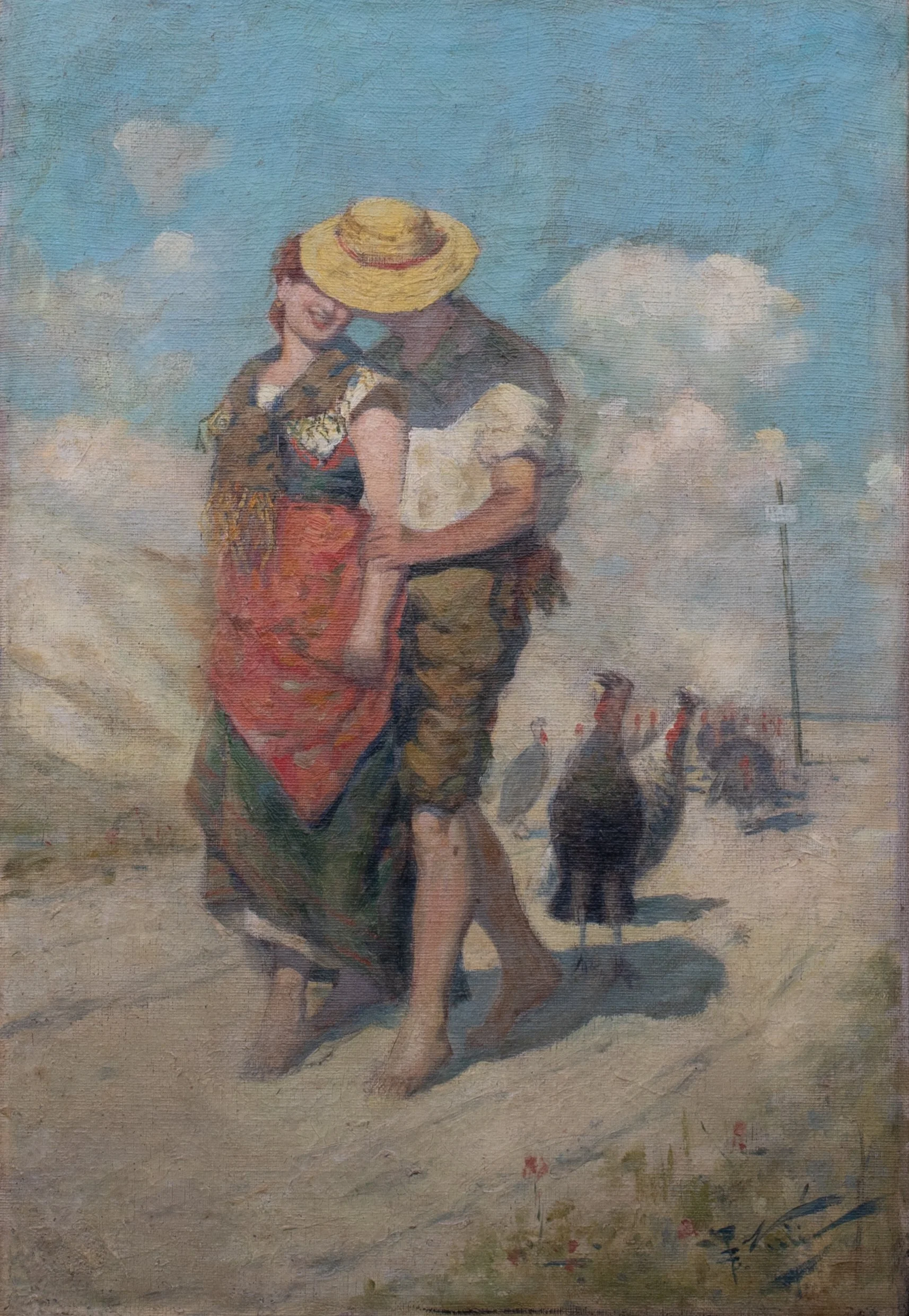Girolamo Pieri Nerli
The Springtime of Life, 1890
Oil on canvas, 39 x 26.5 cm
Signed
From Frances Hodgkins to Isabel Field, 9 June 1893, Cranmore Lodge
‘I went to see Mr Cole’s studio today. I admire his work and his method tremendously but I think compared with Nerli his work is lifeless. What an artist a judicious blending of the two would make! Nerli has been most awfully good to me and gives me an extra lesson on Saturdays in his studio’.
Girolamo Pieri Pecci Ballati Nerli (1860-1926) was an Italian painter born into an aristocratic family in Siena. He studied art under Antonio Ciseri and Giovanni Muzzioli and emigrated to Australia in 1885. After a short stay in Melbourne he moved to Sydney, where he became associated with the Heidelberg School. He travelled to Samoa in 1892 where he painted the portrait of Robert Louis Stevenson.
Nerli first visited Dunedin in 1889 and settled there in 1893. A colourful figure, he became an influential teacher and exhibitor, with Frances Hodgkins and Grace Joel his principal protégées. In 1893 Nerli was elected to the council of the Otago Art Society and in 1894 he set up the Otago Art Academy along with J.D. Perret and L.W. Wilson in Dunedin’s Octagon.
Nerli was a charismatic teacher and his private classes were so popular that the Dunedin School of Art and Design decided to employ him as a teacher of painting. Having no particular specialty, he produced portraits, landscapes and genre compositions in an impressionistic, animated style which was new to Otago artists. He encouraged his students to look beyond the limitations and restraints of New Zealand art to the innovations of Europe. Nerli encouraged Hodgkins to focus on capturing the natural effects of colour and light by sketching en plein air and his influence can clearly be seen in the fluid watercolour handling of her early works.
Nerli combined different trends of European modernism in his works, choosing to focus on everyday subjects and intimate portraits, rather than grand historical themes. The Springtime of Life has its origins in an 1887 picture by Nerli known as In Transgression or Courtship. The painting illustrated here was exhibited under the present title at the Wellington Art Club’s annual exhibition in the winter of 1894 (no. 151) and again at the Otago Art Society in the following November (no. 105). Identified in Wellington variously as ‘an amorous boy and girl followed by some wondering turkeys’(Wellington Evening Post) and‘a goose-girl and her lover’(New Zealand Times), it was suggested by more than one New Zealand reviewer that its narrative beginnings might have lain in the popular French opera of 1880, La mascotte.
Taken altogether, these possibilities of its meaning perhaps overload this essentially anecdotal genre picture. On a simpler level, it is a prime example of Nerli’s roots in the Macchiaioli, the Tuscan painters of modern life who refreshed Italian art in the 1860s and ‘70s by painting out of doors. It exemplifies the technique that impressed New Zealand audiences in the 1890s, leading to him exercising an influence on Dunedin artists that was unri- valled once James Nairn left the southern centre for Wellington.
If Nerli’s sensibilities tended to the risqué, there was no denying his energetic use of paint to create fresh, brisk and animated figure-paintings which was highly invigorating to the art in his adopted country. ‘Signor Nerli’ spent just over three years in Dunedin. In 1897 he left suddenly and headed north, opening a studio in Auckland. After eloping to Christchurch to marry Marie Cecilia Josephine Barron, the couple set sail for Australia. Nerli’s work continued to circulate in this country, being grouped with that of Petrus van der Velden and James Nairn. By 1906, he was back in the land of his birth, and died in Genoa in 1926.
Provenance
Private Collection, Auckland since c.1960
Illustrated
Peter Entwisle, Michael Dunn & Roger Collins, Nerli - An Exhibition of Paintings & Drawings, (Dunedin Public Art Gallery, 1988) p. 102 (engraving of this work)

